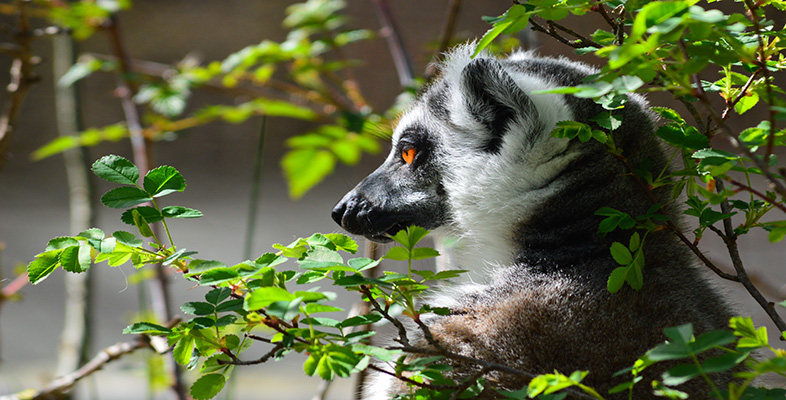2.2 The kinkajou
LoM describes this tree dweller as a relative of the raccoon. It belongs to the order Carnivora and is one member of a family generally referred to as procyonids [p. 170], or more commonly the raccoon family. You'll be aware that some members of this family - for example, coatis [p. 174] - are omnivores. As you'll see in the video sequence below, coatis are more typically found in the undergrowth and leaf litter, rather than high up in the trees. (If you need to remind yourself of the lifestyle of coatis, go back to the previous video sequence and watch the section between 02:20 and 07:05 to see the coatis which feature at the beginning and end of the sequence.)
The kinkajou has a more restricted diet than coatis and is more committed to tree dwelling. It lives in the rainforests of Mexico and Central/South America. Superficially, it has some of the characteristics of primates - features that I'll say much more about in Section 3. For example, it has forward-facing eyes. As the photograph on p. 176 reveals, it also has a strong, monkey-like prehensile tail and clinging, clawed feet. These features allow it to hang down from branches, using dextrous forelimbs to reach the flowers and fruit that (along with a modicum of insects and small vertebrates) comprise its diet. So, in some ways kinkajous are monkey-like in their lifestyle, and yet they only half deserve the name by which they are known by local people - 'monkey of the night'. Indeed, they are nocturnal mammals.
Question 2
Does life in the trees guarantee protection from predators?
Answer
Certainly not, only from ground-based predators! The kinkajou is able to avoid the forest floor at night-time; this location is especially dangerous if jaguars are around [p. 146]. But tree dwellers are increasingly vulnerable to another set of predators, birds of prey. In daylight, kinkajous would be at risk from eagles.
The kinkajou's nocturnal habit helps ensure that predation rates are low. Forest owls might be a threat at night, but the kinkajou - at least the adults - are too large to fall victim to such a predator.
Animals like large herbivores that are heavily predated often live in herds where their strength in numbers mean that combined efforts can help to spot or perhaps fend off predators. For the kinkajou, predation is less of a problem, and may well explain why these animals are largely solitary in their feeding. Careful observations reveal that in more than 80 per cent of cases, individuals feed alone, which reduces the degree of competition between conspecifics, and is especially prevalent when food is less plentiful. Yet kinkajous do come together in well established social groups, just as primates do. In doing so, they display types of social behaviour, such as grooming and play between adults and juveniles, that are important 'bonding' interactions of primates.
Kinkajous have distinctive types of scent glands, located on their chin, throat and chest. Our understanding of what role these secretions play in communication in kinkajou society is very fragmentary, but they're seen as important in marking territorial boundaries between groups.
Question 3
Would it be appropriate to identify the use of scent as a straightforward adaptation to arboreal life?
Answer
To do so, you'd need evidence that this type of communication by smell was uniquely associated with tree dwelling, but this isn't the case. For many ground-dwelling carnivores, for example, smell plays a key role in social interactions; in the civet for instance [p. 142], territory marking by scent is very important.
But olfactory (as well as acoustic) communication often assumes a special importance in animal communities where visual contact is difficult, as would be the case for mammals living amongst dense foliage - and remember too that the kinkajou is nocturnal, so sight is not the most reliable of senses. But for those arboreal species that move swiftly - those that jump from tree to tree, for example - visual precision is needed, especially an ability to judge distances expertly. So the exact mix of the different senses shown by different tree-dwellers varies a good deal from one species to another, which is a factor worth watching out for as we look at other species.
